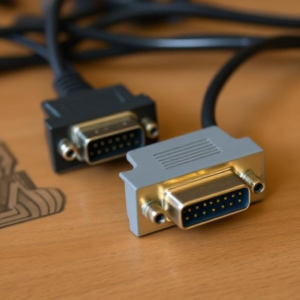RS-232 (Recommended Standard 232) is a standard used for serial communication, allowing data to be transferred one bit at a time over a single communication channel. It’s commonly used to connect computers and devices like modems, printers, and sensors.

1. What is Serial Communication?
Serial communication sends data one bit at a time over a single wire. This is different from parallel communication, where multiple bits are sent at once over several wires. RS-232 is a serial communication protocol, meaning it transmits data one bit at a time.
2. The RS-232 Connector
RS-232 devices usually connect through a 9-pin (DB9) or 25-pin (DB25) connector. These connectors are often found on older computer equipment.
- DB9: 9 pins for data and control signals
- DB25: 25 pins for a wider range of data and control signals
3. How It Works:
RS-232 uses two main lines to communicate:
- TX (Transmit): This pin sends data from one device to another.
- RX (Receive): This pin receives data.
Other lines are used for things like signaling whether the device is ready to send/receive data, error checking, and flow control.
4. Voltage Levels
RS-232 uses voltage levels to represent data:
- Logical “1” (Marking): Typically between +3V to +15V (sometimes called “positive voltage”).
- Logical “0” (Spacing): Typically between -3V to -15V (sometimes called “negative voltage”).
These voltage levels distinguish between data states. If the voltage is high (positive), it represents a “1”. If it’s low (negative), it represents a “0”.
5. Data Framing
RS-232 transmits data in the form of a frame. Each frame consists of several parts:
- Start bit: Marks the beginning of the data transmission (usually a “0”).
- Data bits: The actual data being transmitted (usually 5-9 bits).
- Parity bit: Optional bit for error checking (can be even, odd, or none).
- Stop bits: Marks the end of the transmission, and helps the receiver know when the data frame has ended (usually 1 or 2 bits).
6. Baud Rate
The baud rate is the speed at which data is transmitted. It tells you how many bits per second are sent. For example, a baud rate of 9600 means 9600 bits per second. Both devices must communicate at the same baud rate for successful communication.
7. Full Duplex vs Half Duplex
- Full Duplex: Both devices can send and receive data at the same time (e.g., a phone call).
- Half Duplex: Data can only be sent in one direction at a time (e.g., a walkie-talkie).
8. Applications
RS-232 was widely used for connecting personal computers to peripheral devices, such as:
- Modems
- Printers
- Mouse devices
- Early networking hardware
Today, it’s less common in modern devices, but it’s still used in legacy systems and some industrial applications.
In summary:
RS-232 is a simple communication standard that uses voltage levels to represent data. It works by sending data one bit at a time, with added features like error checking and start/stop bits to ensure reliable communication. It’s not as fast or modern as other protocols, but it was a workhorse in computing and electronics for many years
Tags: 25-pin, 9-pin, asynchronous communication, baud rate, bidirectional communication, bits per second (bps), communication channel, Communication Protocol, control signals, data bits, data framing, data integrity, data lines, Data transmission, DB25 connector, DB9 connector, early networking, error checking, flow control, frame structure, full-duplex, half-duplex, hardware interface, industrial applications, legacy hardware, legacy systems, logical 0, logical 1, modems, negative voltage, old computing standard., one bit at a time, parity bit, peripheral devices, positive voltage, printers, reliable communication, RS-232, RS-232 Communication, RX (receive), Sensors, Serial Communication, serial port, signal polarity, signal transmission, simple protocol, single-direction communication, start bit, stop bits, synchronization, transmission speed, TX (transmit), voltage levels


